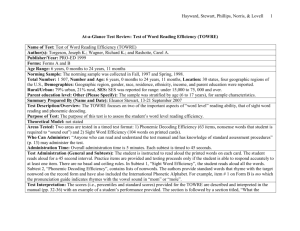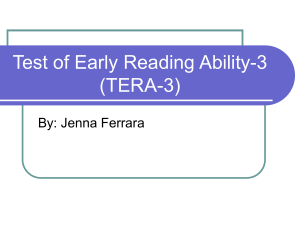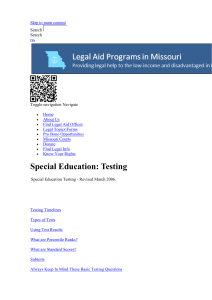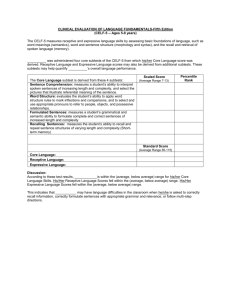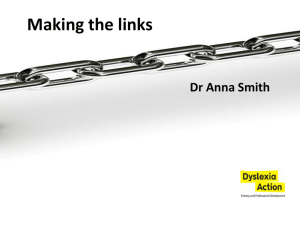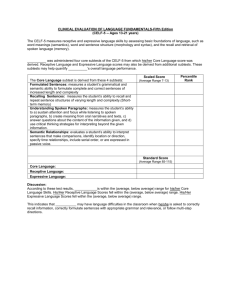Test of Word Reading..
advertisement
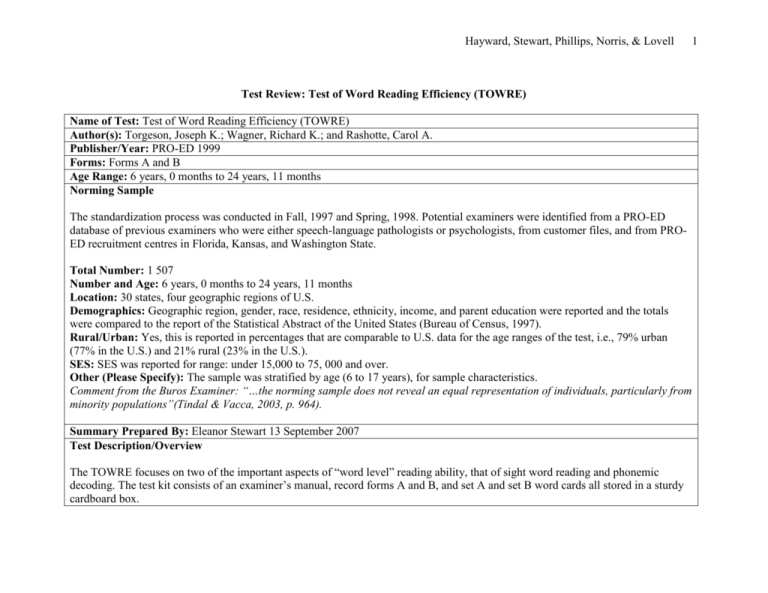
Hayward, Stewart, Phillips, Norris, & Lovell 1 Test Review: Test of Word Reading Efficiency (TOWRE) Name of Test: Test of Word Reading Efficiency (TOWRE) Author(s): Torgeson, Joseph K.; Wagner, Richard K.; and Rashotte, Carol A. Publisher/Year: PRO-ED 1999 Forms: Forms A and B Age Range: 6 years, 0 months to 24 years, 11 months Norming Sample The standardization process was conducted in Fall, 1997 and Spring, 1998. Potential examiners were identified from a PRO-ED database of previous examiners who were either speech-language pathologists or psychologists, from customer files, and from PROED recruitment centres in Florida, Kansas, and Washington State. Total Number: 1 507 Number and Age: 6 years, 0 months to 24 years, 11 months Location: 30 states, four geographic regions of U.S. Demographics: Geographic region, gender, race, residence, ethnicity, income, and parent education were reported and the totals were compared to the report of the Statistical Abstract of the United States (Bureau of Census, 1997). Rural/Urban: Yes, this is reported in percentages that are comparable to U.S. data for the age ranges of the test, i.e., 79% urban (77% in the U.S.) and 21% rural (23% in the U.S.). SES: SES was reported for range: under 15,000 to 75, 000 and over. Other (Please Specify): The sample was stratified by age (6 to 17 years), for sample characteristics. Comment from the Buros Examiner: “…the norming sample does not reveal an equal representation of individuals, particularly from minority populations”(Tindal & Vacca, 2003, p. 964). Summary Prepared By: Eleanor Stewart 13 September 2007 Test Description/Overview The TOWRE focuses on two of the important aspects of “word level” reading ability, that of sight word reading and phonemic decoding. The test kit consists of an examiner’s manual, record forms A and B, and set A and set B word cards all stored in a sturdy cardboard box. Hayward, Stewart, Phillips, Norris, & Lovell Purpose of Test: The purpose of this test is to assess the student’s word level reading efficiency. Areas Tested: Two areas are tested in timed test format: 1. Phonemic Decoding Efficiency-63 items, nonsense words that student is required to “sound out” 2. Sight Word Efficiency- 104 words on printed cards Phonological Awareness Segmenting Blending Elision Reading Single Word Reading/Decoding Comprehension Rhyming Other nonwords Who can Administer: This is not specified except to state, “Anyone who can read and understand the test manual and has knowledge of standard assessment procedures” (Torgeson, Wagner, & Rashotte, 1999, p. 13) may administer the test. Administration Time: TOWRE has a very short administration time of 5 minutes. The presentation of items is timed to 45 seconds. Test Administration (General and Subtests): The student is instructed to read aloud the printed words on each card. The student reads aloud for a 45 second interval. Practice items are provided and testing proceeds only if the student is able to respond accurately to at least one item. There are no basal and ceiling rules. In Subtest 1, “Sight Word Efficiency”, the student reads aloud all the words. Subtest 2, “Phonemic Decoding Efficiency”, contains lists of nonwords. The authors provide standard words that rhyme with the target nonword on the record form and have also included the International Phonetic Alphabet. For example, item # 1 on Form B is mo which the pronunciation guide indicates rhymes with the vowel sound in “mom” or “mole”. Test Interpretation: The scores (i.e., percentiles and standard scores) provided for the TOWRE are described and interpreted in the manual (Torgeson, et al., 1999, pp. 32-36) with an example of a student’s performance provided. The section is followed by a section titled, “What the TOWRE Scores Mean”. Supporting research is referenced. The next section focuses on “Instructional Implications for Low Scores on Each Subtest”. The authors provide information on general trends in reading instruction with the caveat that much remains to be discovered about what poor performance indicates, when to intervene, and what to do in intervention. The authors’ interpretation of 2 Hayward, Stewart, Phillips, Norris, & Lovell younger children’s performance, they note that “the test may measure slightly different skills at different periods in reading growth” (p. 42). Discrepancy analysis is done in order to decide whether the difference in scores constitutes an important, rather than mere chance, difference. Minimal differences between TOWRE scores indicating clinical significance are presented in Table 4.4 (p. 45). To avoid the possibility of over-identification, the authors recommend a 19-20 point difference in subtest scores be used to decide whether the results show important difference. A student’s progress can be monitored over a school year by the administration of alternate forms. Standardization: Age equivalent scores Grade equivalent scores Percentiles Standard scores Stanines Other (Please Specify) A total standard score is calculated from the two subtest standard scores Comment: The usual cautions are given regarding age and grade equivalent scores. The authors note that funding agencies and legislation may require reporting of these types of scores. Reliability: Internal consistency of items: Internal consistency was investigated using alternate-form reliability since TOWRE is a speeded test. Both forms were administered during one session, “correlated at 13 different age intervals using the test performance of the entire normative sample as subjects” (Torgeson, et al., 1999, p. 58). The subtests and the total scores all exceeded the .80 level, ranging from .86 for Sight Word Efficiency at 17 years to .97 for this subtest at ages 6 and 7 years. Average coefficients, across the age intervals, for both subtests and the total were .93 to .96. Standard Errors of Measurement: SEMs provided ranged between three and six with averages of four for subtests and three for the Total Word Reading Efficiency. Test-retest: 72 participants in three age ranges, 6 to 9 years (Grades 1 to 4, n=29), 10 to 18 years (Grades 5 to 12, n=17), and 19 to 24 years (working or in college, n=17) from Tallahassee, Florida were retested after a two week interval. Standard scores correlated with mean and standard deviations were presented for each testing. The values of r ranged from a low of .82 (Sight Word Efficiency for 19 years), to a high of .97 (Sight Word Efficiency for 6 to 9 years) with most (17 of 24) values at or above .90. Inter-rater: Two PRO-ED staff members independently scored 30 randomly selected completed tests. The sample included completed tests for Grade 1 to Grade 12. Coefficients were .99 across the subtests and the total test. Comment: Though the practice of having two staff members participate in determining interscorer reliability appears to be common, a Buros reviewer in another review pointed out that this is not strong evidence if the testing has already been done. The reviewer 3 Hayward, Stewart, Phillips, Norris, & Lovell 4 preferred the method whereby two scorers observe and score the test as it is being administered to the student. I’m sure that for practical reasons this is not generally done. However, I also believe it provides more convincing evidence. Other: When testing for equivalence of forms, coefficients were .86 or better, with most above .90. The authors state, “Both forms of the sight Word Efficiency and Phonemic Decoding Efficiency subtests have almost identical means and standard deviations and correlate .86 or better with each other at each age” (Torgeson, et al., 1999, p. 64). Validity: Content: These authors are well-known in the field. They provide brief descriptions of the two aspects of reading tested by the TOWRE, citing key research to support their rationale for choosing these skills as targets. They state that item selection was based on “criteria involving frequency of occurrence in printed texts beginning at the elementary school level, length and complexity of syllables, and number of syllables” (Torgeson, et al., 1999, p. 67). The Reading Teacher’s Book of Lists (Fry, Kress, & Fountoukidis, 1993) was the primary source consulted for word selection. Words were arranged in the test lists from high frequency to less frequent occurrence. Conventional Item Analysis: Item difficulty and item discrimination are reported. Discrimination indexes of .35 or higher with values for median discriminating powers ranging from .40 to .75. Median Item Difficulties: The item difficulty of the TOWRE meets the requirement. Differential Item Analysis: Using a logistic regression procedure with alpha set at .001, DIF analyses demonstrate that bias in these subtests appears to have been kept to a minimum. Criterion Prediction Validity: Concurrent Validitity: TOWRE was compared with WRMT-R at three grade levels. Correlations ranged from .89 to .94. In another study, 201 randomly selected elementary aged children were followed longitudinally, and correlations between TOWRE and WRMT-R subtests ranged from .86 to .89 at Grades 4 and 5. Predictive Validity: Children in grades 4 and 5 were tested and coefficients ranged from .47 (GORT-3 Rate and TOWRE Phonemic Decoding Efficiency) to .87 (WRMT-R Comprehension and TOWRE Sight Word Efficiency). In another longitudinal study, 201 randomly selected fifth grade children participated, and authors examined the relationships among the same subtests. Stronger relationships are demonstrated between whole word readings skills and text reading and comprehension than decoding skills. Construct Identification Validity: Age differentiation: The means and standard deviations across all 13 age groups show a high correlation of age with performance (0.77 to 0.81). Group differentiation: Data are provided for the following groups: males and females, ethnic groups (European, African, Hispanic, and Asian Americans), and two categories of students with disabilities (speech Hayward, Stewart, Phillips, Norris, & Lovell 5 language and learning disability). Examining mean standard scores on subtests across these groups indicated that gender and ethnic groups all performed within the normal range. Data suggest minimal test bias for gender and ethnic groups. Students with speechlanguage difficulties performed better than students with learning disabilities. Subtest Interrelationships: Coefficients range from 0.77 to 0.96. Factor analysis: Confirmatory factor analysis demonstrates that the two subtests were related but addressed different aspects of word reading efficiency. Item Validity: All discrimination coefficients reported in Table 7.1 (Torgeson, et al., 1999) are above .35. Word Reading Efficiency of Students with Severe Reading Disabilities: Children identified with severe word level reading difficulties who were given 67 hours of individual instruction in an eight-week block were tested. The results were presented in terms of gains in standard scores across several standardized measures of word reading skills (WRMT-R, GORT-3 and TOWRE). Performance on the TOWRE subtests accurately reflected the small improvements that occurred in reading fluency, and was much less affected by the relatively large increases in accuracy as reflected by both the word reading accuracy score on the GORT-3 and performance on the untimed measure of word reading (p. 83). Differential Item Functioning: not stated Other: none Summary/Conclusions/Observations: Comment from Buros reviewer, John J. Vacca: “…it is unclear how the words selected on the TOWRE (both real and nonsense) related to the ample information presented in the authors’ discussion of the test’s rationale. Further, it is equally unclear how the 45second time frame was decided. In summary, the development of the TOWRE has clear roots in the overall importance of reading development and effective teaching of reading. However, the authors failed to provide information that relates this to the item development, scoring procedures, and utility of the tool” (Tindal & Vacca, 2003, pp. 963-964). Does this test indirectly assess vocabulary? I’m also a little uncomfortable about the timed aspect of this test. In working with some clinical populations, there may be a processing lag that will bias the test results. Though the authors included disability categories in their standardization sample, the categories represented do not include some of the newer categories found in student populations such as children with traumatic brain injuries (TBI). Also timed tests have been known to disadvantage some groups. So, again, I am not sure what is gained by introducing this element in the test process. Hayward, Stewart, Phillips, Norris, & Lovell 6 In an age of accountability in education, I wonder if the age and grade equivalents provided are very tempting to use despite the important cautions which discourage use. Clinical/Diagnostic Usefulness: This test is user-friendly and easy to administer with a minimum of materials needed. Given the brevity of the test, it is an attractive choice in a busy world. It would be tempting to use it. If a child did poorly, I would also wonder about other areas of language. I might use this test first but find myself backtracking in this case. References Fry, E. B., Kress, J. E., & Fountoukidis, D. L. (1993). The reading teacher’s book of lists. Englewood Cliffs, NJ: Prentice-Hall. Tindal, G., & Vacca, J. (2003). Test review of the Test of Word Reading Efficiency. In B.S. Plake, J.C. Impara, and R.A. Spies (Eds.), The fifteenth mental measurements yearbook (pp. 960-965). Lincoln, NE: Buros Institute of Mental Measurements. Torgeson, J. K., Wagner, R. K., & Rashotte, C. A. (1999). Test of word reading efficiency. Austin, TX: Pro-Ed. To cite this document: Hayward, D. V., Stewart, G. E., Phillips, L. M., Norris, S. P., & Lovell, M. A. (2008). At-a-glance test review: Test of word reading efficiency (TOWRE). Language, Phonological Awareness, and Reading Test Directory (pp. 1-6). Edmonton, AB: Canadian Centre for Research on Literacy. Retrieved [insert date] from http://www.uofaweb.ualberta.ca/elementaryed/ccrl.cfm.
